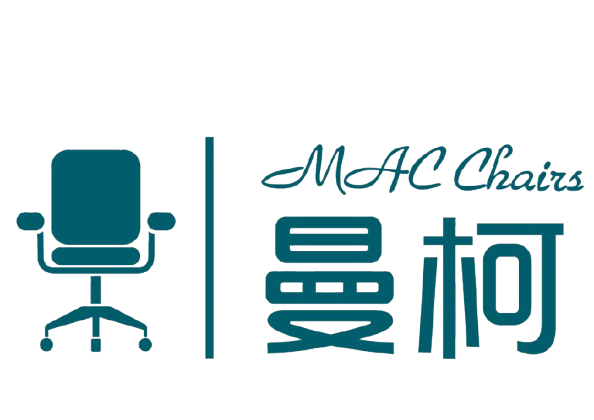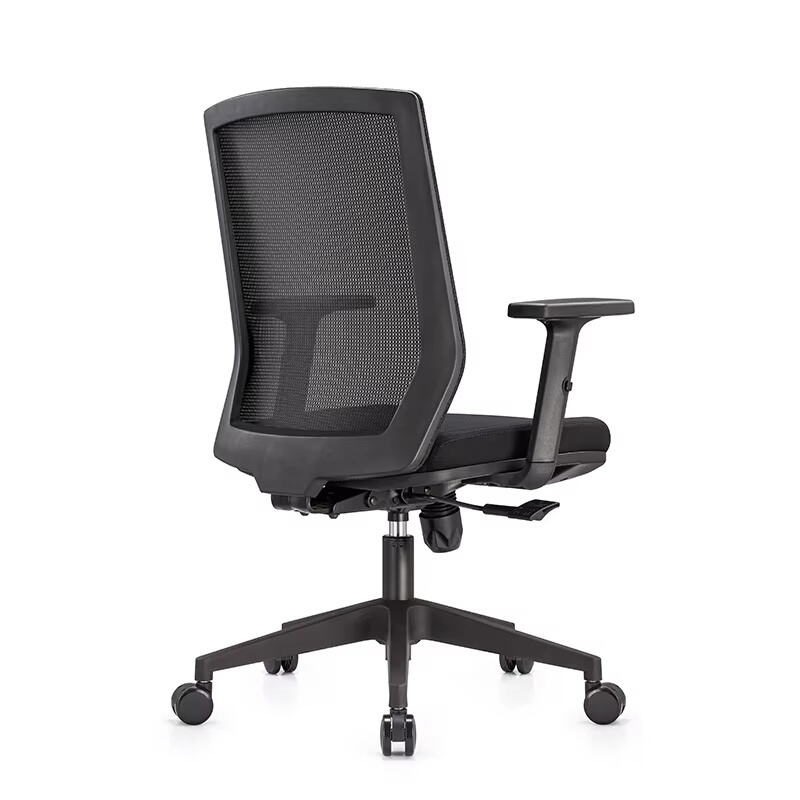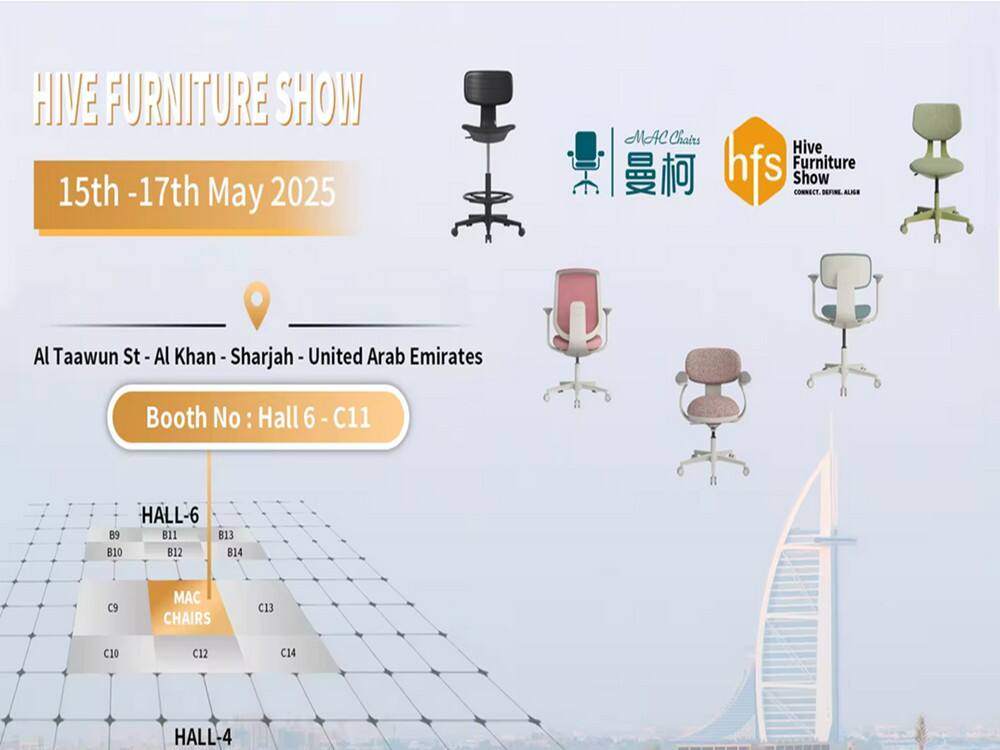
Ergonomic Foundations in Modern Office Chair Design
Adjustable Lumbar Support for Spinal Alignment
Good lumbar support matters a lot when talking about ergonomics, especially since around 8 out of 10 people deal with back pain sometime in life. Office chairs with adjustable lumbar features help keep the spine aligned properly when someone sits for long hours at their desk. Getting this right for each person's body shape helps maintain that natural spinal curve, which cuts down on discomfort and makes sitting straighter feel more natural. Studies show there's a clear link between decent lower back support and workers getting stuff done faster. When the spine isn't struggling against poor chair design, people don't get as tired sitting down, and they can concentrate better on what needs doing. That's why these days most sensible workplaces invest in chairs that actually support the lower back properly.
Dynamic Movement Features for Active Sitting
Active sitting brings movement right into the chair itself, making it part of everyday seating habits. Many modern office chairs come equipped with all sorts of moving parts these days - think swivel bases that let people turn around easily, or seats that tilt forward when needed. The idea is simple enough: get folks shifting positions more often instead of staying stuck in one spot all day long. People who spend hours at their desks report feeling less tired overall, plus they tend to stay focused longer on tasks. Industry professionals working on ergonomics have noticed this too. They see how chairs that allow some motion help workers avoid those mid afternoon slumps where nothing seems to matter anymore. So adding some flexibility to chair designs does more than just protect backs and legs. It actually creates workplaces where employees feel better physically and mentally throughout their shifts.
Breathable Materials for Extended Comfort
Breathable materials in office chairs really matter when someone needs to sit for hours on end at their desk. Mesh upholstery does double duty by controlling body temperature while letting air flow through, which stops that uncomfortable sweatiness from building up. What makes these moisture wicking fabrics so good? They basically stop the annoying discomfort that comes from sitting too long in one place. Companies have actually done some research showing that what kind of fabric covers those chairs affects how happy employees feel about their workspace. Going with breathable options definitely helps people stay more comfortable and actually get things done during their day job. When companies pick out chair materials carefully, they're not just looking at looks anymore but thinking about how those choices impact both comfort levels and productivity rates across the office.
##Material Innovation for Durability and Aesthetics
High-Tech Mesh Fabrics for Airflow
Mesh fabric has really taken off in office chair designs because it lets air flow through so well. Workers sitting for hours on end appreciate how these materials prevent them from sweating all over their clothes at desk jobs. The market sees two main players right now - elastomeric meshes that stretch without tearing, and polyester blends known for holding up against daily abuse. Some folks swear by the bounce back factor of elastomeric stuff after years of sitting on it, whereas others prefer the tough exterior of polyester mixes that just keep going despite spills and coffee rings. Chair makers often point out that besides keeping people cooler, these advanced meshes last much longer than traditional upholstery options. That means companies don't have to replace chairs as frequently, saving money in the long run even if the initial price tag looks steep.
Sustainable Material Choices in Modern Designs
People want greener stuff these days, so office chairs are getting made from better materials now. Most folks care about what they leave behind on Earth, and companies have noticed. That's why we see lots of office furniture coming with recycled plastic parts or even bamboo frames mixed in. Using these stuff cuts down on trash piling up and saves trees basically. Market numbers show that offices are going green more than ever before. Makes sense really since it matches what many clients expect nowadays. Sustainability isn't something extra anymore for most workplaces. It's becoming part of how offices look and function day to day across the board.
Metal and Leather Combinations for Professional Settings
Metal frames paired with leather upholstery have become something of a standard in upscale corporate offices across the country. Metal gives furniture solid support, whereas leather brings that classic look many businesses want to project. These materials last longer than cheaper alternatives too. Leather needs regular cleaning and conditioning to keep looking good, while metal frames just keep going year after year without showing wear. Companies such as Herman Miller and Steelcase know this well, which is why they incorporate both elements into their designs. Their office chairs and desks manage to look great while standing up to daily use from busy professionals who sit at them all day long. Even after years of sitting on these pieces, they still maintain that premium appearance that makes clients think twice about what kind of business they're dealing with.
##Adaptability for Diverse Office Spaces
Modular Design Elements for Meeting Room Chairs
Meeting room chairs with modular design are changing the game when it comes to office space usage. What makes these chairs so great? They give businesses tons of flexibility to arrange seating however they need. Take a look at what happens in practice: most modular chairs can be moved around quickly or stacked away when not needed, which means offices get more bang for their buck in terms of available space and seats. Tech startups especially have jumped on board with this approach, rearranging their conference areas throughout the day as team sizes fluctuate. The real benefit here goes beyond just saving floor space. When people can adjust their surroundings to match what they're working on, meetings tend to run smoother and teams actually collaborate better because everyone feels comfortable in whatever setup works best for them.
Space-Saving Solutions for Compact Workstations
When space really matters, good design becomes everything for those cramped workstations we all deal with these days. Folding desks and stackable chairs make smart use of what little room there is, and they still manage to keep things comfortable enough for most people. Even when the space feels tight, workers don't have to suffer through bad posture or lost productivity. Remote work has taken off quite a bit lately, something like 44% more folks working from home since 2020 according to some reports. That means space saving ideas aren't just nice to have anymore but actually necessary for setting up decent home offices in apartments and small houses where every square foot counts. People are finding creative ways to fit their work lives into whatever space they've got available.
Integration with Technology in Conference Chairs
Conference chairs with tech features are really taking off these days, since people rely so much on gadgets during meetings now. Most models come with power outlets and USB ports built right in, which means no more scrambling for extension cords when laptops run low. Tech innovations keep changing how we think about office furniture, and this trend is definitely making waves in workplaces across the country. Some forward thinking companies have even started adding wireless charging pads to their meeting room chairs, along with sensors that track occupancy patterns. These smart additions do more than just look cool they actually help boost productivity by keeping everyone connected and comfortable throughout long brainstorming sessions or client presentations.
##Minimalist Aesthetics in Contemporary Chair Design
Clean Lines and Neutral Color Palettes
The clean lines and simple shapes we see in office furniture really affect how a workspace looks overall. For chairs in today's offices, going minimalist creates that ordered, calm vibe everyone wants these days. These designs just fit right in with the rest of modern office decor without sticking out. Neutral colors play a big role too. Whites, greys, and beiges tend to make people feel relaxed rather than stressed. Most companies stick to these because they work well with almost anything else in the room. Take those slimline office chairs with basic colors for instance. They don't take up visual space and let other design elements shine through. People actually notice when designers pay attention to details like this. The whole office feels better somehow, making workers concentrate more easily and stay calmer throughout the day.
Functional Yet Stylish Features for Modern Offices
Getting the right mix between function and looks when designing office chairs matters a lot these days. Good chairs need to do two things at once: keep people comfortable while looking nice enough to fit into any workspace. Most offices now want adjustable armrests and height controls because they let workers tweak their seating just right without making the chair look cluttered or complicated. These adjustments mean individuals can find what works best for them personally, all while keeping things simple visually. Designers in the field talk about this balance constantly, pointing out how proper chair design really does affect how happy employees are and how much work gets done throughout the day. When companies start combining those newer ergonomic technologies with attractive designs, everyone wins since it creates better spaces where people actually want to spend time working.
Enhancing Office Productivity Through Simplicity
Simple office furniture designs actually work wonders for boosting productivity because they cut down on distractions in busy workplaces. Studies show people perform better when their surroundings aren't too complicated visually. Take companies like Google and Apple for instance these tech giants redesigned their offices with clean lines and minimal decor and saw real results. When an office space focuses on straightforward design elements rather than flashy decorations, workers find it easier to concentrate without all that mental noise getting in the way. Many businesses report seeing productivity jump after switching to minimalist setups. The whole point is creating spaces where staff members can stay focused on what matters most without getting sidetracked by unnecessary visual clutter around them. So if a company wants to get more done, going minimalist in office design makes sense both practically and economically.
##Balancing Form and Function in Modern Workspaces
User-Centric Design Approaches
Putting users first when designing office furniture matters a lot these days because workplaces keep changing so fast. Good designers spend time figuring out what people actually need at their desks before jumping into production. Ergo experts get involved early on too, making sure everything fits how humans naturally move around, which cuts down on back pain and keeps folks feeling better throughout the day. Take those new meeting room chairs for example they've got all sorts of adjustments now from seat height to lumbar support so different body shapes can find something comfortable. The famous Aeron chair from Herman Miller comes to mind here lots of offices have them setup because employees report less fatigue after sitting in them for hours during long meetings or work sessions.
Alignment with Open-Plan and Hybrid Office Layouts
Office chairs have become essential components in today's hybrid and open plan offices, which many companies are gravitating toward as they evolve. These kinds of layouts support teamwork while still giving space for solo work, so chairs need to handle multiple roles without issue. Take rolling conference chairs for example they can be moved around easily from meeting rooms to workstations, making it simple to rearrange spaces when needed. More and more companies are actually starting to invest in such setups, which means manufacturers see growing interest in chairs that adapt well to changing needs. According to recent market analysis, there's expected expansion coming for modular office furniture across North America, largely because businesses want their workplaces to stay flexible rather than fixed.
Future-Proofing Through Flexible Chair Features
Workplaces keep changing all the time, so we really need office chairs that can adapt if they want to stay useful for longer periods. When designing chairs, manufacturers should think about adding things like height adjustments and parts that can be swapped out or upgraded. This kind of flexibility meets what people need right now while also getting ready for whatever comes next in how offices are set up. Companies working in furniture design, take 9to5 Seating LLC for instance, have noticed this trend and stress how important it is for today's office chairs to be able to handle different situations as work environments continue evolving. With more and more companies adopting hybrid setups where some folks work from home part of the week, having chairs with lots of options becomes even more critical. Chairs that last longer and can do multiple jobs help cut down on waste and save money over time too.











